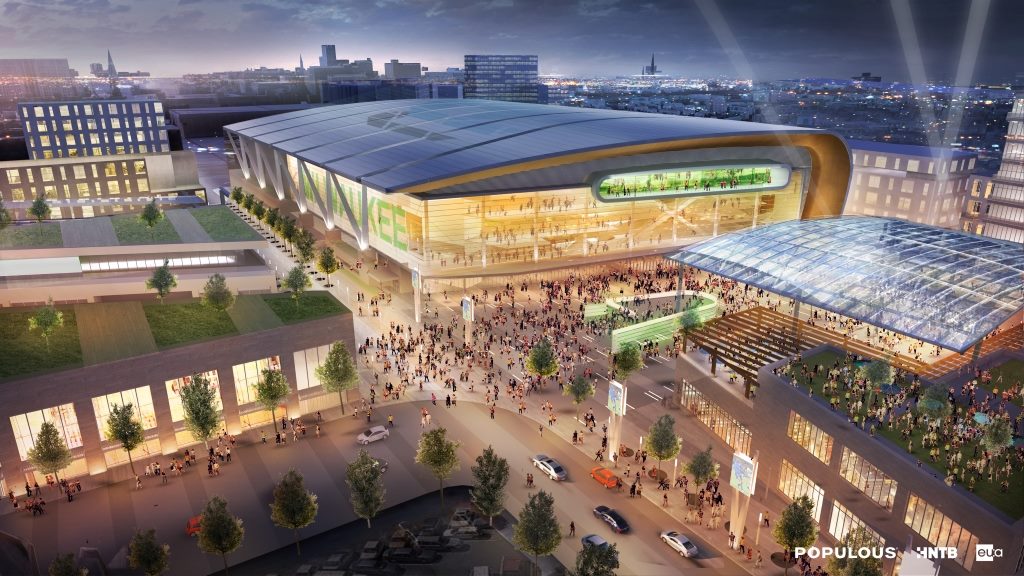No, It’s Not Cheaper to Keep Them
Subsidy for Bucks' arena won't save money for taxpayers, as Republican Rep. Dean Knudsen has pointed out.
As the legislature nears a vote this week on using taxpayer dollars to help build a new Bucks arena, Gov. Scott Walker‘s primary argument for subsidizing the Bucks continues to be the contention that it’s “cheaper to keep them.” That isn’t exactly an uplifting slogan, but it seems to be the strongest argument the governor can muster. With that in mind, let’s review the arguments about the cost-effectiveness of public subsidies for the proposed arena.
There have been a number of excellent columns, blog posts and other commentaries about the arena issue. Among those, my favorite is a critique of the “cheaper to keep them” argument by Republican Representative Dean Knudson.
In a guest column he wrote in mid-June, Knudson skewers each of the three major points that the governor and others have made to support the argument that the proposed public subsidies will be less expensive than the costs to be incurred if the Bucks leave Milwaukee:
1) Current income tax paid by players would be lost – This argument is one of my pet peeves, so I was very happy that Knudson effectively summarized a counterpoint that economists often make about the fallacy of assuming all the spending and related income tax revenue will simply dry up. As Knudson explained:
“If the team moves, the dollars spent each season on the Bucks will instead be spent on other forms of entertainment, movies, travel, restaurants, tourism, advertising, etc. This redirected spending will be spread among thousands of businesses in the state, generating sales tax, income tax and property taxes, significantly offsetting the income tax no longer paid by NBA players.”
2) NBA income tax growth would be lost – A key part of the governor’s case is the argument that new TV deals are going to sharply boost NBA players’ salaries, which Walker projects will jump to $149 million in 2020, $260 million in 2030, $450 million in 2040 and $610 million by 2046. Knudson points out that “NBA player salary increases are difficult to predict,” and he notes that published reports put the NBA team salary caps for the 2018-19 season at $100 million, which is well below the amount the governor has been assuming in 2020.
3) State taxpayers would be responsible for $120 million in maintenance and debts on the Bradley Center – Rep. Knudson argues that the cost of “deferred maintenance” referenced by arena promoters “has been exaggerated.” He points to an estimate of “$16 million in needed repairs to the current arena,” and he adds:
“Wisconsin law is very clear that state taxpayers have no liability whatsoever for the Bradley Center, for its maintenance or its debts. Legislative attorneys confirm this interpretation.”
To Knudson’s cogent rebuttal of the governor’s three primary parts of the governor’s calculations, I would add that if you don’t limit the equation to just the state share of costs, some of the analyses haven’t fully counted all the local subsidies.
For a longer discussion of the “cheaper to keep them” claim, see this June 18 PolitiFact column. It also points out a number of the flaws in the governor’s assertion, but unlike most PolitiFact commentaries, it doesn’t rate the claim.
In closing, I think the question of whether it’s “cheaper to keep them” is definitely a relevant part of the debate about the arena plan, but it’s not the most important question. I believe a much more pertinent question now is whether helping finance the arena plan is the most cost-effective use of those state and local tax dollars.
I don’t want to see the Bucks leave Wisconsin, but at a time when spending is being cut from public education and many state and local services, I think there are higher priorities for using public dollars to invest in Wisconsin’s future.
Jon Peacock is research director for the Wisconsin Council on Children & Families
Arena Renderings
Op-Ed
-
Unlocking Milwaukee’s Potential Through Smart Zoning Reform
 Jul 5th, 2024 by Ariam Kesete
Jul 5th, 2024 by Ariam Kesete
-
We Energies’ Natural Gas Plans Are A Mistake
 Jun 28th, 2024 by John Imes
Jun 28th, 2024 by John Imes
-
Milwaukee Needs New Kind of School Board
 Jun 26th, 2024 by Jordan Morales
Jun 26th, 2024 by Jordan Morales
























This article is nonsense
“If the team moves, the dollars spent each season on the Bucks will instead be spent on other forms of entertainment, movies, travel, restaurants, tourism, advertising, etc. This redirected spending will be spread among thousands of businesses in the state, generating sales tax, income tax and property taxes, significantly offsetting the income tax no longer paid by NBA players.”
This is a huge assumption. Maybe sales tax revenue would increase, but we would lose the income tax revenue. The big losers would be areas of Wisconsin that are far from Milwaukee. If the Bucks leave I may spend more time in Chicago over the winter, but I’m not going to Mercer or Steven Point….. I can promise you that. Or maybe I finally get HBO and stay home. I’m not the only one. Also, how many $30,000 per year jobs would need to be created to make up $10M + in lost state income tax revenue? (3,000+) Furthermore, we become even less attractive to people looking to relocate. Death by a thousand lashes.
Also, in regards to point #2. You didn’t really argue against it, you just point out that the projections are a little optimistic. That may be true, but there is no doubt the salary cap will be significantly rising in the near future (by exactly how much is pure conjecture at this point). And yes, we’ll be missing out on all of that growth if the Bucks move.
In a guest column he wrote in mid-June, Knudson skewers each of the three major points that the governor and others have made to support the argument that the proposed public subsidies will be less expensive than the costs to be incurred if the Bucks leave Milwaukee: Skewers? Really. There is no skewering going on here.
In addition to being wrong about Point #1, the author has no clue about Point #2. I agree with James. Regarding Point #3, Knudson is correct. And he’s only correct because without the Bucks we would tear down the BC. And of course, if we tear it down we wouldn’t have to pay for upkeep. Skewers?!?! Right.
#1 – what event/events will draw hundreds or even thousands of people from Chicago to Milwaukee from November to May? Those are hotel dollars and sales tax dollars generated by out-of-state people. Income tax from players will be lost, if they don’t play in WI, income tax isn’t generated and $6.5 million dollars will not be made up by people going to movies or going to a bowling alley.
#2. The salary cap in the NBA has gone up $17 million in the last 10 years, when the new TV deal takes place, the salary cap is projected to go up by $40 million dollars. The NBA is also one of the only leagues that has a salary floor. Teams will HAVE to spend at least $80 million dollars starting as early as next off season. It’s not known how many teams will pay UP to the cap, I’ll give you that, but it’s not hard to figure out how much teams will at least be paying their players.
#3 If no new arena, there will be fewer concerts and events and eventually none at all as the Bradley Center gets older and older. There will not be NCAA tournament games played and the “home court” advantage that Wisconsin benefited from in the 2014 run may never happen again. That run may not have happened if the team was playing something else. The Admirals could be moved to a different city by their NHL parents in Nashville, TN. As draws to Milwaukee go away, hotels will close because there is no demand, bars will close because there aren’t more than the regulars coming. Sales tax income will go down because people have nothing to spend their money on and property tax income will go down because people will move out.
#4 A new arena and entertainment district opens up a world of possibilities – it opens Milwaukee up as suitor destination for an NHL team as well as opening up Milwaukee as a destination for an NBA All-Star game, a host for the NFL draft, more NCAA tournaments, more concerts and more events. All of those not only generate sales tax and property tax from Wisconsin residents, but it draws tourists from out of state, people that don’t live here will come and spend their money.
I like your enthusiasm, but ignorance is a pet peeve.
If this pathetic attempt at an argument is the best the opposition can do I am feeling very optimistic about the arena passing!
Come on guys!!! Why do you let this stuff get published? Why so anti-arena? This is silly! BUILD IT NOW!!!!
People don’t comprehend the size of the NBA’s new TV contract. $2.67 billion spread across 30 teams means the Bucks’ share is $89 million a year (or $145 per paid admission—based on their actual 2014-15 paid attendance of 611,226).
The TV contract is equivalent to raising the average ticket price by $145!
This is money NOT coming from Wisconsin sources but which is taxed in Wisconsin. This money (and the taxes it generates) will be lost if the Bucks leave.
Anyone notice that James, David and Nick are the same person?
I hate to let “Nick” know that the proposed new arena will not have the Admirals or any hockey team play there. The Admirals will be moving to the old UW Panthers Arena. I also have to question his assumption that the new arena opens up “world of new options”. What would we get that we don’t get now. PS This argument was used before when they were building the Bradley Center. it never came true. Another point, the existing hotels, restaurants and bars were not built just to service patrons of Bucks games. I highly doubt that their business will dry up because there aren’t Bucks games that is pure exaggeration at best. I am also trying to figure out how people who live far away from the arena benefit from them currently or from a new arena. People in western Wisconsin are more inclined to go to Timberwolves games than Bucks games anyway.
I would also like to point out that the income tax revenue collected would go to the state, not the county or city. If the state is the entity that would benefit from this ugly boondoggle let them pay for it. Why should the Milwaukee taxpayers pony up for all the freeloaders upstate.
The Rock, not sure why you are suggesting that David, Nick, and I are the same person… odd comment (and obviously not true).
In regards to one of your comments, the “people who live far away” benefit via the state receiving income taxes from NBA-related salaries. This is money that is used on projects around the state and would go away should the Bucks leave.
Go back to sleep Rock.
@therock
“What would we get that we don’t get now.”
A 5 figure increase in new residents, 5 figure increase in new commercial sq. ft., a new public space, new parking, new entertainment options. That enough for ya? The Kissinger building that was just sold was appraised at 500k before this and was sold for 3.1 million, 6x appraised value. That a good thing in your eyes, or nahhhhhh?
“This argument was used before when they were building the Bradley Center”
So an investment of 500 million in ancillary development was pledged by the old owners alongside the Bradley center like it is now? I don’t seem to remember that…
” I highly doubt that their business will dry up because there aren’t Bucks games that is pure exaggeration at best”
Ya but it is a portion of their business. Are you willing to say that harm resulting from losing 10% of your business in the winter is “an exaggeration”
Mr. Peacock (and Rep. Knudson) – How can you in good faith make the comparison in #1? Use your brain. You’re comparing apples to oranges. Yes, as it relates to sales and use tax revenue, some economists have set out theories that spending dollars by residents may just move from once source of entertainment to another if a professional sports team left. That has nothing to do with income tax revenue generated by very highly compensated earners that would not be working in this state if the Bucks did not exist–and who will not be working in this state if the Bucks leave. Mr. Knudson was clearly trying to be sneaky by casually slipping “income tax” into his comment. That’s despicable. If he wasn’t intentionally being sneaky, that’s just as bad, for then he’s a representative of this state who does not understand the benefit that highly compensated workers provide to the state’s revenue–that’s downright scary.
The State cannot replace $6.5 million of income tax revenue lost when the Bucks leave by its resident going to the movies. It may be able to replace some of the sales tax revenue that is generated from the hundreds of thousands that attend Bucks games and go out to nearby restaurants when doing so, but many doubt that, because more is typically spent by a family going to a Bucks game than one that, for example, goes to a movie.
@therock
I reread more of your idiotic comments and will comment further
“Another point, the existing hotels, restaurants and bars were not built just to service patrons of Bucks games.”
Wow, that is an incredibly insightful point. Next thing your gonna tell me is downtown Green Bay wasn’t built for the Packers only.
” I am also trying to figure out how people who live far away from the arena benefit from them currently or from a new arena.”
I’m not going to get into how taxes work but here’s the cliff notes. A State (WI is a State) collects taxes and spends to benefit inhabitants of the State with better roads, schools, etc. This money is collected from private businesses (the Bucks are a private enterprise). Big private businesses create big tax receipts so more people in the state benefit.
There are benefits to keeping the Bucks. It’ just a question of how much public subsidy makes the equation really work for taxpayers. It appears that once boosters buy into “we need the Bucks to stay,” the discussion basically ends. That’s why the Bucks have completely controlled every aspect of negotiations. The public’s deal makers have whimpered and caved to every Bucks demand (with negligible concessions–we’re still stuck at $250M–plus all the other freebies, such as half the city’s parking income). Make that everyone but Walker, who gallantly offered $220M and quickly realized the absurdity of relying on optimistic income-tax projections to repay bonds. He’s got political chops and a campaign to launch, so he wisely left the wrangling to others.
So Abele devised convoluted schemes that put the biggest burden on the County and the silenced WCD (the latter to start payments in 2028!). And Barrett agreed to pretend that blowing up a garage built for $30 million–as well as a thriving business district–were small sacrifices to keep the Bucks–plus $47 million for a new garage and infrastructure.
Team pride may be the best payback for a community. How much is that worth? Priceless, as those ads say. It’s also completely un-quantifiable. I’m guessing it’s worth quite a bit for all the people who’s esteem for Milwaukee (or self-esteem as area residents, including WOW suburbs) is so low that a little NBA-Bucks-Prozac reportedly makes it soar. That may be worth $400 million in cash and interest, 25 or 30 acres of free land, parking garages, entertainment malls, plazas for the Bucks to generate money from, status as “master developer” of Westown, renaming it Bucks Town–you name it. If that’s what it takes to elevate Milwaukee’s collective mood, it could be a good return on all that taxpayers invest. Since that can’t be measured, we can simply claim the ROI was off the charts…
And if Abele gets crowned King of Milwaukee County and Superintendent of (Shadow) MPS by state GOPs for all his water carrying, well darn, he earned it. I hope they can find a headpiece that’s big enough…Maybe the Bucks will make him their new mascot!
One simple equation:
The state says it will collect $299 million in Bucks-related income taxes over 30 years.
The state estimates payment on arena bonding and interest will be $400 million. A $101 million shortfall.
Talk about fuzzy math!
M…… the state would borrow $40-$50M which will cost $70-$80M. The state stands to make over $200M over 30 years.
M, the estimated state payments are actually $80 million.
You’re included county/city portions for which it is much more difficult to calculate their return.
The supporters always tout how much more income tax the State will be getting because the NBA is making money hand over fist. So in other words, these guys really do have enough money to build this thing without a subsidy, right?
It’ll also be interesting to see if the arena does spur development. A big reason the arena is being done is to capture more revenues for the Bucks. That will come at the expense of the businesses already there.
In addition to the $80 million the state is borrowing which does not include interest, the convention center which is owned by the state is borrowing $93 million. Payments on that $93 million will not begin until 2028 and won’t be paid off until 2048. In that time interest will accrue. An interesting quote from Senator Lena Taylor.
“Who has a loan for 13 years and you don’t pay anything, but you let the interest run? Who does that? You wouldn’t let your kids do it,” State Sen. Lena Taylor said. “And you sure as heck wouldn’t do that to your constituents.”
http://deadspin.com/the-milwaukee-bucks-are-already-threatening-to-move-1716190249
As anyone who has a 30 year mortgage will tell you the total principal and interest payments over the term will be up to three times the original amount borrowed. In other words the convention center will pay up to $279 million just for its portion. It maybe even more if you add the complexity of the interest running for the first 13 years because no payments are to be made.
The Bucks in the past couple of weeks have just made a $70 million contract commitment to one player (Khris Middleton) and a $50 million contract commitment to another player (Greg Monroe). The Bucks owners are only committing $150 million to the stadium, with another $100 million coming from a gracious gift by the previous owner, Senator Kohl.
I like the Bucks. I hope they stay. But I can’t understand why the public has to provide $250 million (not including interest) towards the infrastructure and facilities for a team that can literally commit $120 million more to its labor costs in about a week’s time. Even more, the Bucks still won’t pay any local property taxes on said infrastructure and facilities and apparently won’t even make a voluntary contribution toward local services such as police, fire, winter street maintenance, etc.
Who buys a car or house without knowing the details about what they are about to purchase? Not many do, but that is what the Bucks are asking the public to do with its investment in half of the cost of the arena. The Bucks chose the location and the design. Although the Bucks will be managing and operating the arena, it has yet to publicly state whether there will be an ice sheet in the arena (leaving the Admirals to wonder what will occur), let alone provide any detail about the clubs, suites, shops, and restaurants in the arena. Similarly, will the team provide a facility for children similar to Helfaer Field or the right field area inside Miller Park? Will the team pursue NCAA tournaments, even outside of basketball?
The arena should be built, for the good of the city and region. But before a significant public investment is made, the team should release more details about what it intends to do with the arena. It may even sway some legislators to support the arena before a vote next week.
David and others: I believe the state fiscal bureau is currently estimating the taxpayer bonding payments at various levels at $400 million including interest. Not sure if that includes the city’s portion. Perhaps not, since that’s being treated as a stand-alone deal. It may well not include all the WCD interest once it’s deferred for 13 years.
The problem with saying the state gets a $200-$300 million return for its $80 million is that, as others noted, it does not include all the other prongs, for which no return is anticipated beyond bragging rights and maybe some modest property tax gain, in a decade or three after all the TIFs are repaid.
The County Comptroller, Scott Manske, did a thorough analysis that essentially said the county will lose money if the state starts collecting debt the county now collects, and there’s also the chance not enough will be collected. It boils down to the county shelling out $4 million a year to cover that bonding, however it’s calculated. It’s not like they found some new money under a mattress. Manske says they are now collecting something like 95% of the collectible debt within about two years. (Some debt truly is incollectible and should not be factored in).
The scheme to piggyback on the WCD taxes starting in 2028 is very risky. Some compare it to deals hatched before the Great Recession, only for individual home-buyers and such, not state entities. It also jeopardizes current and future plans for WCD propeties–without their having any say. Talk about top-down.
Every time someone suggests a way to return some of the cash produced at or through the arena (ticket fees, naming rights, a stake in the franchise) Bucks and boosters respond as if taxpayers want to sacrifice the Bucks first-born child. Will anyone ever start looking at this as a true business “50-50 partnership” instead of a just way to fleece taxpayers. Any sane business person would have rejected this deal long ago and demanded some return other than future taxes, if all goes as hoped. Even that may only be half of what the public invests (not counting the city’s giveaways).
I don’t care at all about basketball, or about basketball fans, or the billionaire New York owners of the Bucks.
If these billionaires can’t pay their own bills, they shouldn’t let the top of the door frame hit their players in the head, as I’m sure it won’t hit them. Listen to Bruce Springsteen’s “Glory Days” and you’ve got the sports fan pegged, they’re old, fat, ex jocks who want to relive high school. I would rather have a team sent, to terminate these billionaires with extreme prejudice, than pay their laughable extortion. It would be worth forgoing any and all pro team sports, anywhere, just to defy cocky rich fools.